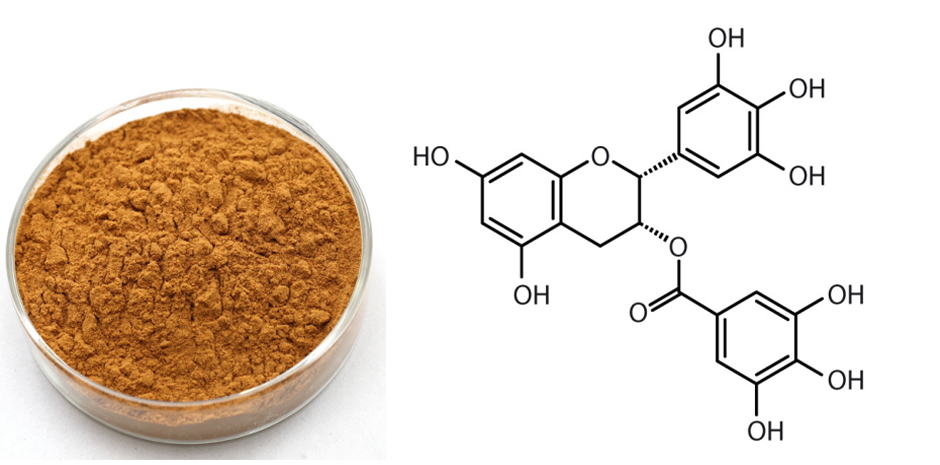2016 New Style Green tea extract Supply to Barcelona
2016 New Style Green tea extract Supply to Barcelona Detail:
[Latin Name] Camellia sinensis
[Plant Source] China
[Specifications]
Total tea polyphenols 40%-98%
Total catechins 20%-90%
EGCG 8%-60%
[Appearance] Yellow brown powder
[Plant Part Used] Green tea leaf
[Particle size] 80 Mesh
[Loss on drying] ≤5.0%
[Heavy Metal] ≤10PPM
[Storage] Store in cool & dry area, keep away from the direct light and heat.
[Package] Packed in paper-drums and two plastic-bags inside.
[What is green tea extract]
Green tea is the second largest beverage demanded by consumers worldwide. Used in China and India for its medicinal effects. There are several compounds extracted from green tea including catechins which contain an enormous amount of hydroxyphenols that are easily oxidized, congregated and contracted, which explains its good anti-oxidation effect. Its anti-oxidation effect is 25-100 times as strong as those of vitamin C and E.
It is widely used in medicines, agriculture, and chemical and food industries. This extract prevents cardio-vascular disease, lowers the risk of cancer, and decreases blood sugar and blood pressure, as well as viruses. In the food industry, the anti-oxidation agent used for preserving food and cooking oils.
[Function]
1. Green tea extract can reduce blood pressure, blood sugar, blood lipids.
2. Green tea extract has the function of removing radicals and anti-aging.
3. Green tea extract can enhance the immune function and prevention of colds.
4. Green tea extract will anti-radiation,anti-cancer, inhibiting the increasing of cancer cell.
5. Green tea extract used to anti-bacterium, with the function of sterilization and deodorization.
[Application]
1.Applied in cosmetics field, Green tea extract owns the effect of anti-wrinkle and anti-Aging.
2.Applied in food field, Green tea extract is used as natural antioxidant, antistaling agent, and anti-fading agents.
3.Applied in pharmaceutical field, Green tea extract is used to prevent and cure cardiovascular disease, diabetes.
Product detail pictures:

Related Product Guide:
Adhering to the principle of "quality, service, efficiency and growth", we have gained trusts and praises from domestic and international client for 2016 New Style Green tea extract Supply to Barcelona , The product will supply to all over the world, such as: South Korea, Bogota, Holland, Since its foundation , the company keeps living up to the belief of "honest selling , best quality , people-orientation and benefits to customers. " We are doing everything to offer our customers with best services and best products . We promise that we'll be responsible all the way to the end once our services begin.
https://diabetic-diet-plan.researchedbyyou.com – Diabetic Diet Plan Tips
Top 10 Superfoods – Healthy Foods You Shouldn’t Do Without
They are typically loaded with health-promoting perks, from essential vitamins to antioxidants to flavanoids. As potent wellness boosters, they are known to combat cancer, lower cholesterol, fight heart disease and reduce your belt-size.
1.Acai Berry
Growing on palm trees in the Amazonian rainforest, this Brazilian berry is rumored to be the best superfood around. With its high fiber, high protein and low sugar content, açaí can be found in smoothies, frozen yogurts, juices and even alcoholic beverages. Though their nutritive benefits are on par with blueberries, cranberries and strawberries, açaí berries boast ten times the amount of antioxidants found in red grapes. Antioxidants, as the name
implies, counter the effects of cell oxidization, protecting against free radicals and possibly reducing high blood pressure and helping to prevent heart disease.
2. Cinnamon
As this sweetly scented spice helps balance blood sugar, it can be beneficial to prevent diabetes (or: it can be a beneficial addition to the diets of diabetics). Moreover, cinnamon’s anti-inflammatory properties can alleviate the symptoms of arthritis.
3. Citrus Fruit
Whether one prefers grapefruits, oranges or tangerines, citrus fruits are high in vitamin C, which is needed to fight off colds and nasty flu viruses. Oranges, tangerines and grapefruits have been proven to prevent many kinds of cancer, too, such as prostate, lung and breast cancers.
4. Cranberries
Loaded with proanthocyanidins (a type of antioxidant-rich, free-radical-fighting flavanoid), this crimson-red berry can help cure urinary tract infections and other bacterial diseases with just a daily dose. Besides the benefits for the blood, these tart, cancer-fighting berries are excellent for the mouth. We’re not just referring to taste, though they are delicious. Cranberries have been shown to prevent cavities and gum disease.
5. Garlic
Don’t shrink from the stink just yet; the pungently scented bulb lowers blood pressure as well as reduces the risk of getting bacterial infections. Garlic also acts as an anti-inflammatory, alleviating ailments such as arthritis and asthma.
For more diabetic diet plan tips go to ~
https://diabetic-diet-plan.researchedbyyou.com – Diabetic Diet Plan Tips
6. Kale
This ruffled leafy vegetable boasts a healthy dosage of calcium, vitamin B6 and lutein, helping prevent both skin and eye ailments. As with other cruciferous vegetables, kale is in the
vanguard of cancer-preventing foods.
7. Pomegranates
Well-represented in ancient art and literature, pomegranates have been slow to migrate away from the Mediterranean and Middle East. Only recently have the seeds of this superfood been found sweetening dishes, such as soups and salads, in Western countries. Drinking the juice of this seedy red fruit promotes a healthy heart as well as helps combat stroke, hypertension and Alzheimer’s disease. In Ayurvedic medicine, pomegranates are used as a traditional remedy for diarrhea, dysentery and intestinal parasites.
8. Pumpkin
The meat, seeds and oil of this fall-favorite squash possess vital nutrients that reduce signs of aging as well as the risk of prostate cancer in men. In addition to boasting a high mineral content, pumpkins are also anti-diabetic, antioxidant, anti-carcinogenic and anti-inflammatory.
9. Chia Seeds
Just two tablespoons of tiny chia seeds distributed over the course of the day provide your body with high levels of protein, fiber and omega-3, for effects that are energizing, detoxifying and heart-healthy. When consumed raw, chia seeds are crunchy and not unlike poppy seeds in their texture and size. Almost flavorless, they allow you to sneak them into many foods without even noticing their presence. Try them in your yogurt, oatmeal or salad for an added dose of calcium, iron, copper and zinc. Soak chia in any liquid (Mexicans do it with fruit juice to create a drink known as chia fresca) and they expand into a gel several times the size of the original seed.
10. Watercress
In some regions of the world, watercress is regarded as a weed, in others as an aquatic vegetable or herb. Boasting so many health benefits, watercress is definitely not a weed! Most potent when consumed fresh and raw, this leafy perennial helps combat a variety of cancers and has long been used to treat scurvy. Due to its high iodine content, watercress has a strengthening effect on the thyroid gland, which makes it beneficial for sufferers of hypothyroidism.
Article written by Gayot.com
https://www.gayot.com/cooking/top10superfoods/main.html
For more diabetic diet plan tips go to ~
https://diabetic-diet-plan.researchedbyyou.com – Diabetic Diet Plan Tips
Male Enhancement Solution, A Psychological Way to Natural Male Enhancement
The idea of natural male enhancement is an attractive one, probably because so many Americans are getting into the “health kick”by buying organic foods and limited their intake of fast food, processed foods and junk food. The idea of a naturally enhanced sex life is very appealing. However, you have probably heard people saying that supplements do nothing or perhaps even that all these pills have harmful contaminants.
Yes, everything is possible and the FDA has cracked down on a few supplemental companies over the years. Most companies are smart enough to create supplemental products in an FDA-approved facility. In recent years, many supplement manufacturers have actually been bragging about their organic approach to collecting extracts and herbs.
The Science of Male Enhancement
Are the claims of these companies legitimate? Any intelligent person can see the difference between sensational promises and legitimate scientific studies. Many manufacturers do exaggerate the effects of their products. However, there are some companies that do quote legitimate studies, with testimonials from legitimate medical authorities.
Most of these studies involve basic sciences, and not necessarily the brand “Penitriol”or whatever other creative name they’ve come up with. For example, studies have been done on the theory of traction (penis extenders), testosterone producers, L-arginine and vasodilation, which can be chemically manipulated or (supposedly) naturally induced. However, private studies cannot necessarily be presented as fact, and thus the FDA and the medical community cannot truly back any supplemental product.
Instead, individual doctors will back brands that contain natural supplements, which are known to promote general human health. Essential fatty acids, proteins, zinc, vitamins, nutrients—all of these things help sexual function and the overall quality of human life. If you have a deficiency of some sort, then some of these supplemental products will definitely help you. You may even notice an increase in penis size, or longer and harder erections, thanks to an improved blood flow to the penis. If your girlfriend isn’t complaining why stop what you’re doing?
The Psychology of Male Virility
Ultimately, natural male enhancement products are not cures. They are supplementary products, meaning they are help to address deficiencies in your ordinary diet. A man could greatly benefit sexually by focusing on improving his general health—especially as he ages.
It’s also important to realize that many sexual problems with impotence and low libido are psychological in nature. Erectile dysfunction or a lack of interest can be caused by stress, anxiety, sexual fears, poor communication with a partner, and a lack of foreplay. Premature ejaculation is a learned habit, and can be unlearned through stamina-building exercises.
The idea of men becoming “super”in bed and staying rock hard for several hours is a pornographic fantasy. In reality, a woman would probably get tired after hours of penetrative intercourse. If a man really wants to learn to be a good lover, he would focus on learning extended foreplay, perhaps exploring more exotic forms of foreplay. After sufficient stimulation a man can then finish with intercourse. This is a more realistic view of sex, free from sensational promises.
There are natural supplements that can help you in the bedroom, but keeping it “natural”(as in no gimmicks or body manipulation) is the best way to find male enhancement.
The company has rich resources, advanced machinery, experienced workers and excellent services, hope you keep improving and perfecting your products and service, wish you better!






